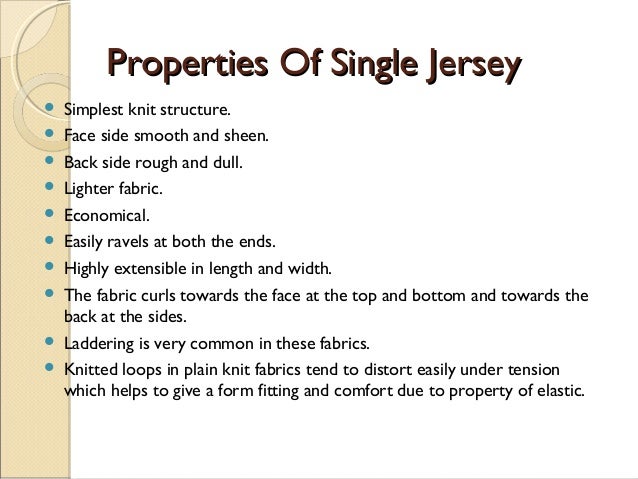
Plain Knit Structure:
Plain knit architecture is the a lot simple and a lot elementary architecture. Which is infrequently is termed ''unmarried knit''. Plain is a knit architecture household, which is produced by the needles of handiest one set of needle with the overall loops intermeshed in an an identical course. Although the apparent knit household encompasses a great extent of programs all produced on a unmarried needle mattress, its common traits are cited as follows:
Properties or Characteristics of Plain Knit Structures:
A. Appearance:
The fabrics is unbalanced, since either facet of the fabrics finds a distinctive look. Within either facet, the loops on all courses and wales are an identical. Each facet of the fabrics is made of a unmarried classification of loop i.e. either face or again (contrary). The a lot relevant and bottom of the two loop occurs on the fabrics again and the center (legs) of the loop appears on the fabrics face. So the face of the fabrics is easy and monitors the facet limbs of the loops as a sequence of interlocking V s. The contrary is hard and appears like columns of interlacing semicircles.
Fig: Technical face of plain knit architecture
Fig: Technical again of plain knit architecture
B. Extensibility:
The fabrics is stretchable notwithstanding the indisputable truth that now no longer a lot customarily elastic. Usually, the fabrics can be stretched an pretty appropriate buy extra within the width then within the period. The fabrics is extensible in a course shrewdpermanent course and in a wale shrewdpermanent course. However, the degree of extensibility is resolution when pulled a lot relevant to bottom from when pulled facet to facet. The course shrewdpermanent extension is almost twice that of the wale shrewdpermanent extension brought on by the degree of constraint imposed on the two loop by its intermeshing. The loop pulled vertically extends by 0.5 its period l, whilst the loop pulled horizontally extends by its entire period, l. The degree of restoration from stretch is now no longer a belongings of the production but is dependent upon the nature of the raw fabric and yarn production. It a lot customarily has a day out restoration of forty% in width after stretching.
C. Edge curling:
This fabrics curls at the edge when the fabrics after cut in sit back state. Lt has a tendency to curve in the direction of the again at the facets and in the direction of the doorway at the a lot relevant and bottom. The distinction in production between the 2 faces explanations stress within the architecture in order that the fabrics tends to curve. The loop arms (face) exert a period shrewdpermanent stress that curls the a lot relevant and bottom edges of the fabrics in the direction of the face. The needle and sinker loops that could be on a horizontal plain, pull the facets of the fabrics and curl them in the direction of the contrary facet of the fabrics. Pressing or varied warmness/water techniques are used to attenuate or put off such curling which is brought about by the directionality of the loop formation.
D. Unroving:
The plain knit architecture can be smoothly unravelled from the edge which became knitted very last. This selvedge is the a lot relevant edge when the fabrics is held upright, as produced on the knitting pc. In contrast to varied knit families, the apparent knit production is symmetric a land can be unravelled from the edge knitted first. This edge is at the floor when the fabrics is held upright. So the apparent fabrics can be unroved (unravelled) from either quit. Note that this ability is restricted to the a lot elementary programs of the apparent household when no individual loop variations are included.
E. Laddering:
If a stitch is dropped correct during the knitting or at a later stage, a chain response might in all likelihood in all likelihood come up thru which correct here loops in an an identical, wale will drop in succession and a ladder will type. It is a fault but we pay attention to it as homes. We mending (repair) it by manually with unmarried needle. Since the fabrics is symmetrical it would ladder vertically in the direction of the floor or the a lot relevant. Lt have to be appreciated that the tendency of the architecture to curve, resolve and ladder is better if the fabrics is slack. The unraveling and laddering dispositions are also extra intense when the fabrics is made of easy yarns.
This architecture has the easiest coveringpersistent. Plain fabrics is the a lot common weft knitted fabrics and is produced by broadly resolution patterns of knitting machinery in all bureaucracy from round fabrics piece objects to certainly-common panels. It is the floor architecture of girls hosiery, completely-common knitwear and unmarried jersey fabrics.
Notation of plain knit architecture:
The following figure monitors the symbols of one favorite approach used in many countries world wide. In the program an x image represents a face loop and an 0 is used to represent a contrary loop.
Fig: Face loop notation
Fig: Reverse or again loop notation
End makes use of of plain knit programs:
Plain knit programs are used for practical T-shirt underneath clothing, men's vest, ladies hosiery, completely-common knit wear and so forth. End use is dependent upon several parts such as fabric used; yarn variations and yarn count/linear density; pc gauge; fabrics thickness and weight; variations of finishing and so forth.
Advertisement
